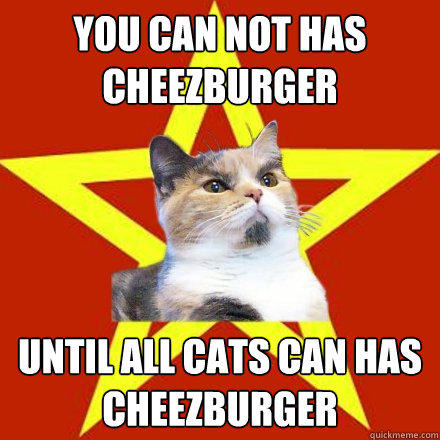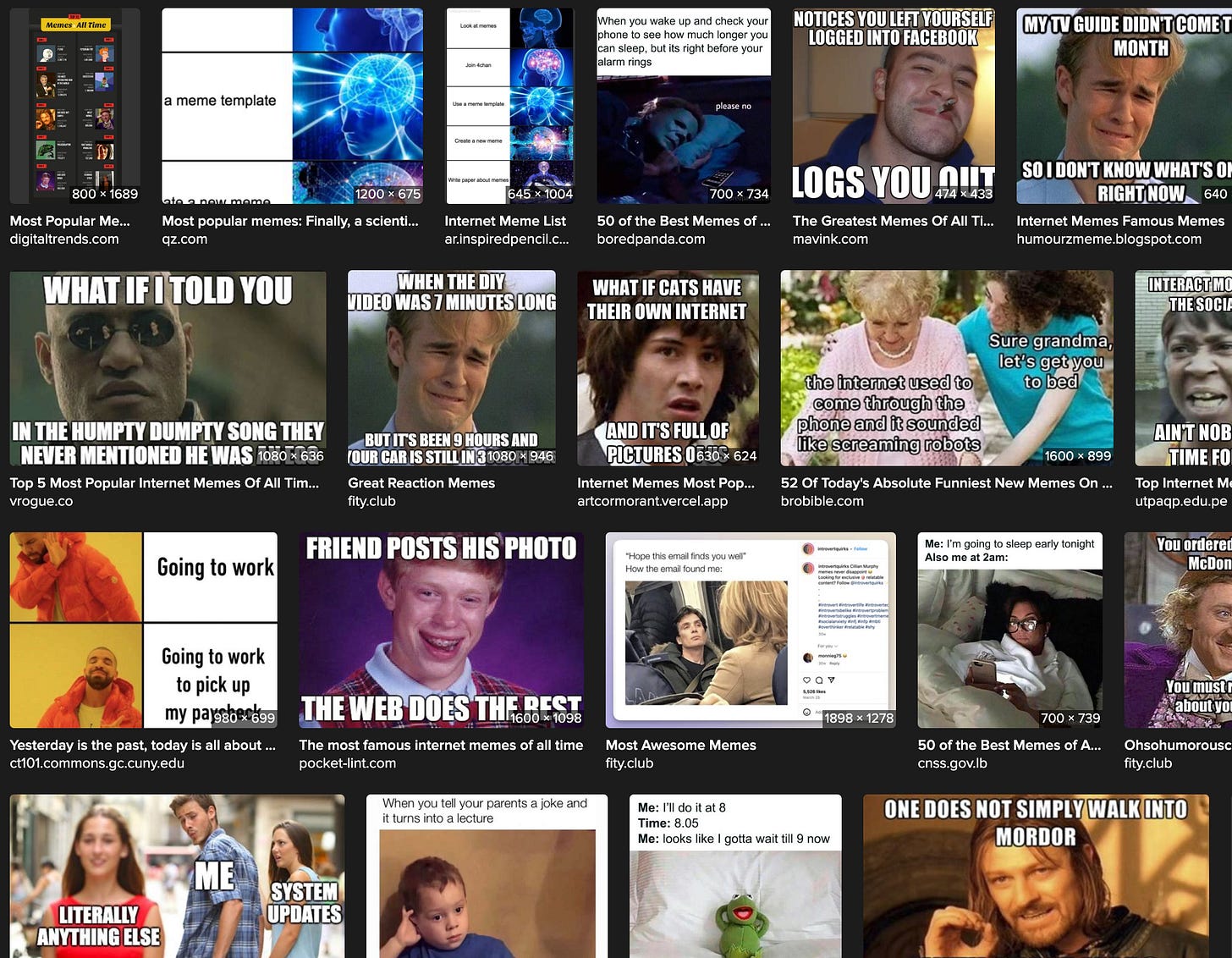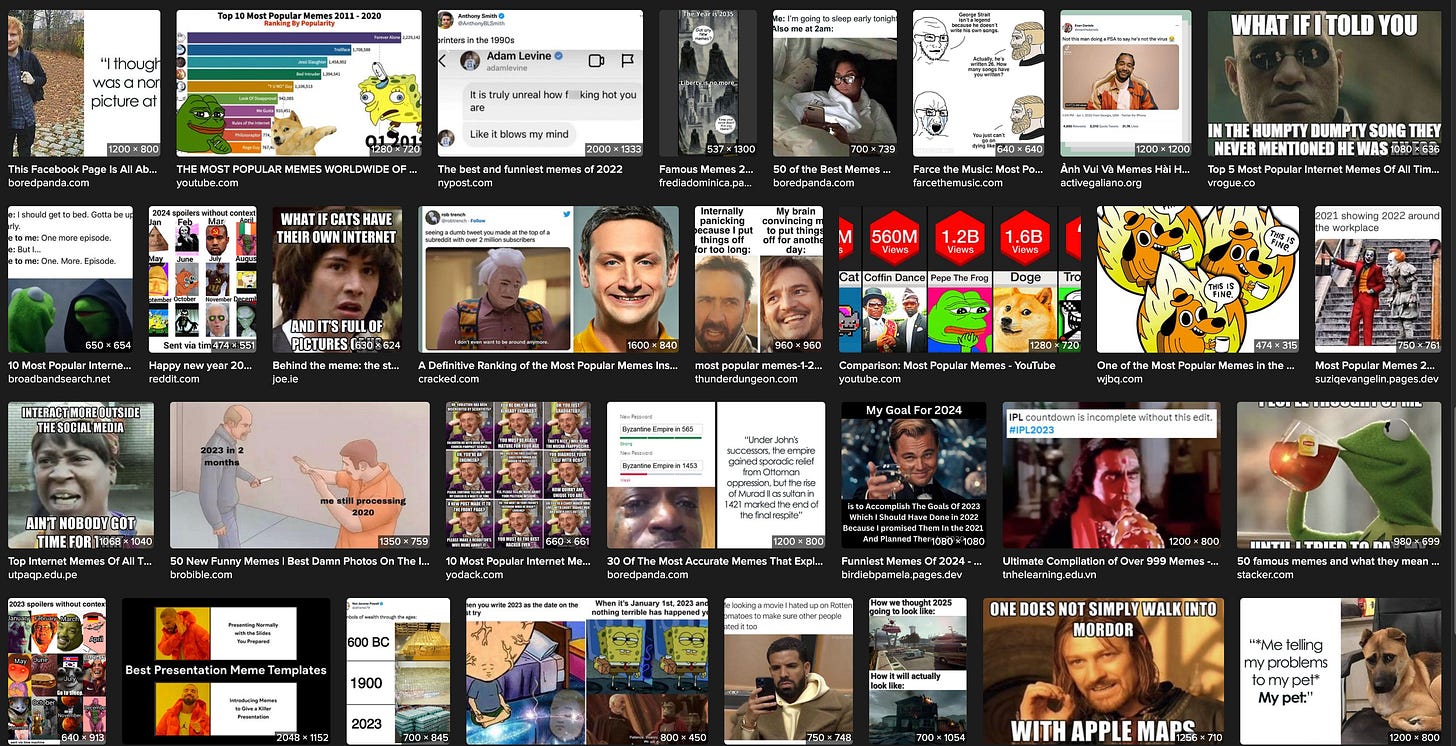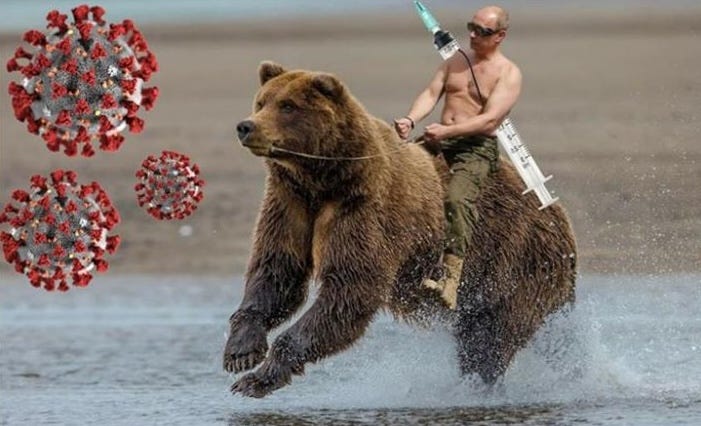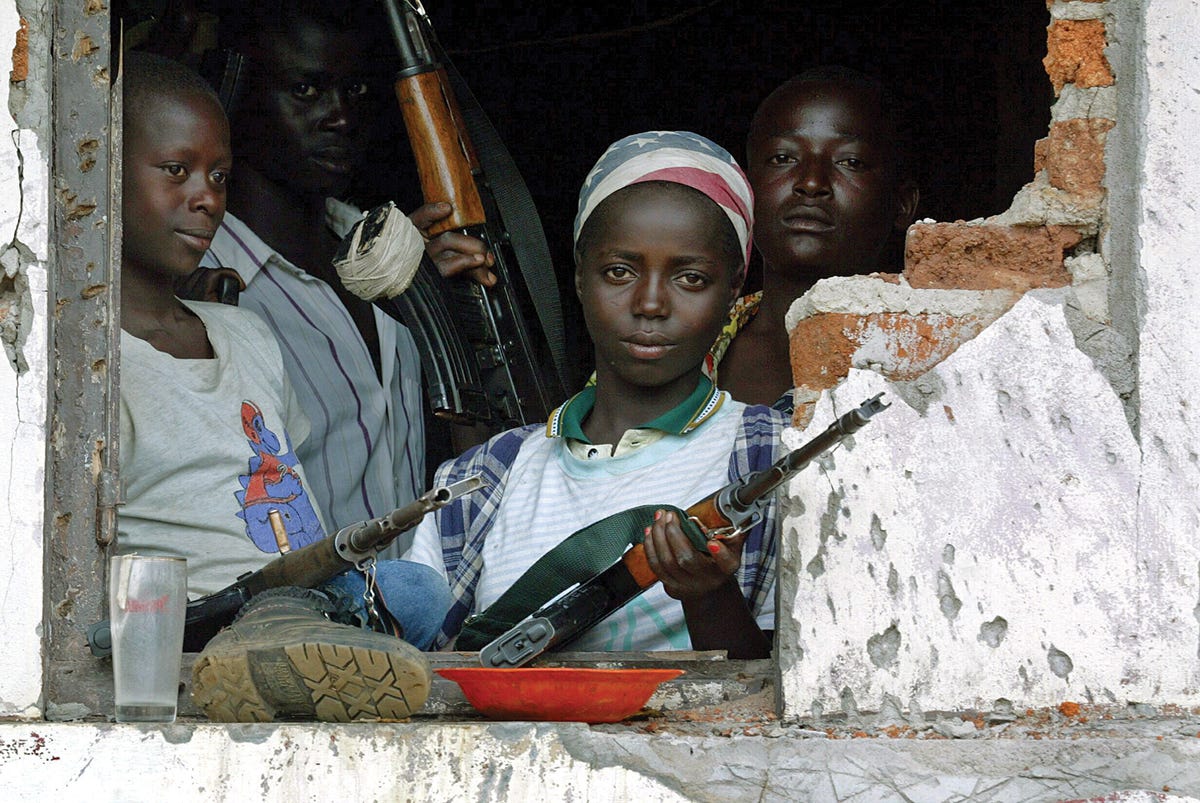From Cat Macros to Cognitive Ordnance
How Memes Became the Kalashnikovs of the West
Part of the Epistemic War series
2. Ghostlands
3. Saturation, Enclosure, Capture, Selective Violence
4. From Cat Macros to Cognitive Ordnance
It is easy, perhaps too easy, to laugh at a cat macro. The grainy image of a kitten with a blocky caption written in a deliberate pidgin: LOLCats, I Can Has Cheezburger, the early grammar of internet culture. At first glance, it looks harmless. A joke in circulation, a shared laugh among strangers scattered across continents. But those images did something deeper: they trained millions of people in the act of replicating and transmitting a symbolic unit with no provenance and no interrogation of intent. They taught us to pick up a template, fill in a caption, and release it into the world. They taught us how to manufacture and redeploy memes without ever thinking of it as a skill. They created, in other words, the literacy of ordnance.
The mid-2000s were the decisive period. This was the moment when internet humor crystallized into a standardized economy of memes. On 4chan, on Something Awful, on YTMND, later on Reddit and Facebook, one could see the market take shape. The rules of exchange were simple: a funny template was a unit of value, and you could spend that value by remixing, reposting, and attaching your own layer of wit. You invested by sharing it at the right moment, in the right thread. You speculated by predicting which image or caption would catch fire. What emerged was not simply humor, but a functioning marketplace of cultural units: a meme economy.
That economy taught scale. It taught speed. It taught that a single clever image could reach millions within hours, riding the viral transmission chains of forums and feeds. Most importantly, it taught a generation to treat cultural artifacts as currency: cheap, disposable, endlessly replicable. Cat macros, rage comics, trollfaces: they were the early tokens of a new kind of economy, one that didn’t trade in money but in attention.
While this economy was emerging from the bottom up, something else was happening in parallel from the top down. In Moscow, military theorists and intelligence planners were publishing openly about a new battlespace: informatsionnaya voyna, information war. The concept was not treated as metaphor or hyperbole, but as doctrine. As early as the 1990s, Russian military journals described the information sphere as equal to land, sea, air, and space. By 2000, Russia had formalized this with its Information Security Doctrine, which declared that control of information, both domestic and foreign, was a matter of national survival.
In these texts one finds the kernel of what would later become familiar to Western audiences: information as both shield and sword, as both defense of the internal population and destabilization of adversaries abroad. Russian strategists wrote that perception was a battlespace, that narratives could disable an enemy as surely as tanks or aircraft. They were explicit: information operations were not support but war itself.
The juxtaposition is striking. On the one hand, anonymous users laughing at cats, remixing jokes, spreading them in a spirit of communal play. On the other hand, a state power, successor to the Soviet tradition of agitprop, laying out a doctrine of information as warfare. At first, the two developments seemed unrelated. But within a decade they converged, and the convergence was not accidental.
The meme economy was an experimental field in which the mechanics of viral transmission were perfected and normalized. By 2005, the grammar was stable: take an exploitable template, add text, repeat. By 2007, the platforms of distribution were vast: Facebook’s News Feed, YouTube’s sharing algorithms, Twitter’s retweet function. By 2010, a teenager could reach the same scale as a newspaper front page with a single successful meme.
For Russia, this was an irresistible vector. It was exactly what its doctrine demanded: a low-cost, high-velocity system for shaping perceptions at scale. To weaponize it required no new invention, only mimicry. State propagandists could cloak their messages in the familiar grammar of internet humor and thereby smuggle ideological payloads into the bloodstream of the meme economy. The same form that carried cats could carry Kremlin narratives, and audiences, already trained to treat memes as unserious, would spread them without suspicion.
This is where the imagery of Vladimir Putin became crucial. The photographs of him shirtless on horseback, practicing judo, piloting jets, personally fighting COVID. These were not merely staged publicity shots, they were memefied images, deliberately constructed to circulate in the same way a lolcat did. They could be remixed, joked about, spread ironically or sincerely. The line between satire and propaganda collapsed, because the image itself was the payload. Whether one shared it in admiration or in mockery, it circulated all the same. That is memetic warfare: a message designed to replicate regardless of the viewer’s intent.
It is tempting to imagine that the West did not notice. But the truth is worse: the West noticed and declined to reframe. The closure of the U.S. Information Agency in 1999 had left a vacuum just as the internet was scaling. Influence operations were scattered across bureaucracies: public diplomacy at State, PSYOP at DoD, cyber defense in technical agencies. No one owned the information battlespace. At the same time, legal and cultural constraints made it nearly impossible to think of domestic information as a battlefield. The Smith–Mundt Act and the Zorinsky Amendment (since rescinded) effectively outlawed domestic propaganda, and the culture of liberal democracy equated any attempt to manage narratives at home with authoritarianism. The assumption was that truth, left free, would outcompete propaganda.
The Russians did not share that assumption. They assumed the opposite: that perception was malleable, that truth had no privileged status, and that the most important task of the state was to control what the population believed. Internally, they built a heavily propagandized media environment. Externally, they prepared to exploit the openness of Western societies. The meme economy offered the perfect opening. By the late 2000s, the convergence was underway. Memes had become the common language of the internet, and Russian doctrine demanded weaponization of common languages. The vehicle was ready, the doctrine was written, and the West was unarmored.
The point here is not to romanticize Russian cunning or to demonize memes themselves. The point is structural. Once the meme economy existed, once memes were standardized as transmissible units of cultural value, it was inevitable that they would be co-opted by state information operations. What looks, in hindsight, like a sudden shift (from cats to Putin, from jokes to propaganda) was in fact the structural convergence of two parallel developments: grassroots memetic play and top-down information war doctrine.
Memetic Ordnance for Western Child Soldiers
The ordnance analogy becomes clear at this point. A meme is not simply a joke. It is a unit of cultural ordnance: cheap, replicable, emotionally potent. The meme economy was the armory. Millions of users, many of them adolescents, were learning to carry and deploy these weapons casually, without ever considering them weapons. To a Russian strategist, this was an extraordinary opportunity. You did not need to radicalize or conscript Western youth; you only needed to insert your payloads into the meme economy and let them do the work for you.
This is the critical reframing: memes are ordnance. They are the Kalashnikovs of the information war: simple, durable, easy to use, devastating in aggregate. And just as images of child soldiers with rifles evoke horror in the West, so too should the sight of Western children casually handling memes. In both cases, the child is not the designer of the weapon but the carrier of it. In both cases, the battlefield has reached down into the everyday, turning play into war without the combatant’s consent.
The West should have recognized the war years earlier. When a state actor (and primary geopolitical adversary) openly publishes doctrine declaring information to be a battlespace, the planners of the opposing camp are meant to take notice. But the American war colleges of the 1990s and 2000s were still caught in a Cold War frame. They understood deterrence in terms of nuclear standoff, conventional force projection, and the precision technologies of the so-called Revolution in Military Affairs. Information, to them, was still a support domain: C4ISR, command and control, networked situational awareness. They had categories for electronic warfare, for psychological operations, for public diplomacy, but they did not see the whole as a battlespace in its own right.
The Russians did. The Russian military press of the 1990s and early 2000s is unambiguous. They described the capacity to disable an enemy’s decision-making through narrative and perception. They spoke of the information environment as territory to be captured and held. And in 2000, Moscow codified this with the Information Security Doctrine: a national-level declaration that information security was central to the survival of the state. Western analysts read these documents, but they read them with the skepticism of victors. The Soviet Union had collapsed; Russia was weak, unstable, a diminished power. Its military journals were treated as rhetoric rather than warning.
At the same time, the West was dismantling its own influence institutions. The United States Information Agency, the flagship of Cold War public diplomacy, was closed in 1999, folded into the State Department, its capacity dispersed and downgraded. The timing could not have been worse. Just as a new global medium was scaling (the internet, with its low-cost distribution and its soon-to-be viral platforms), the United States stepped back from organized narrative strategy. In Moscow, narrative was elevated. In Washington, narrative was privatized, left to the market and the assumption that truth would rise to the top.
This assumption was rooted in liberal faith: to admit that information was a battlefield would have meant admitting that one’s own citizens could be combatants in that battlefield. American legal frameworks, especially the Smith–Mundt Act and the Zorinsky Amendment, prohibited the government from propagandizing its domestic population. There were good reasons for this: a fear of turning the state’s information apparatus inward. But the effect was to create a blind spot. It meant that information could only be conceptualized as free speech, as market behavior, as the natural traffic of a democracy. To frame it as war would have been politically toxic.
The Russians were under no such constraint. They assumed, as doctrine, that information was war. They assumed that their citizens had to be protected from hostile narratives and controlled with domestic propaganda. They assumed that adversary populations were fair game. They assumed that perception was malleable and that truth had no special status. In a closed society with centralized media, this was operationally feasible. In an open society with decentralized platforms, it was a vulnerability.
The asymmetry was stark. Russia could lock down its infosphere, ensuring that foreign memes rarely penetrated beyond the margins. The West left its infosphere open, governed by private platforms whose incentives were not national security but engagement and advertising revenue. The consequence was predictable: the West was permeable, Russia was not. The meme economy thrived in the West because it could; in Russia it was curated, constrained, bent to the will of state narratives.
This is why the West could not “meme back” into Russia with any success. The terrain was hostile. Russian citizens received their information through state television, later through a state-managed internet. A cat macro might spread in Moscow, but an anti-Kremlin meme would be throttled before it left the margins. The battlefield was not reciprocal. It was asymmetric by design.
The result was thirty years of willful blindness. The United States did not lack intelligence on Russia’s intentions. It lacked the will to reorganize itself around the new domain. The events of Estonia in 2007 and Georgia in 2008 were treated as cyber disruptions rather than as integrated information attacks. The annexation of Crimea in 2014 forced a reevaluation, but even then the focus was on “hybrid war” rather than the pure recognition of information as a battlespace. By the time the 2016 election interference made it undeniable, Russia had enjoyed a decade of uncontested operations inside the Western infosphere.
The Endgame
To understand the consequence, one must return to the ordnance metaphor. A meme is a weapon. It is not heavy artillery or a ballistic missile; it is a Kalashnikov, a grenade, an improvised explosive. Its power is not in precision but in replication. It is cheap, portable, easy to use, and devastating in aggregate. Affective legitimacy saturation in motion, for all to see and none to recognize.
Think of the meme as a grenade. A small object, easily carried, quickly deployed. You pull the pin (share, repost, retweet) and the explosion is not physical but emotional. Anger, laughter, indignation, admiration: the blast radius is affective, not kinetic, but it is no less real in its effects on perception. A viral meme can detonate across millions of minds within hours.
Think of the meme as an IED. Improvised, low-cost, placed in high-traffic areas. A doctored image, a provocative caption, a subtle insinuation. Planted in the middle of a popular feed, it disrupts the flow, forces attention, destabilizes trust. It does not need to be sophisticated; it only needs to be well-placed.
Think of the meme as tracer fire. Bright, simple, visible, it marks the battle lines. A political meme signals allegiance, lights up networks of support, reveals where discourse is fracturing. It does not kill on its own, but it shows where to aim the heavier artillery of disinformation campaigns.
These are not metaphors stretched beyond their breaking point; they are structural realities. Memes are ordnance, and Western citizens, especially the young, became the carriers of that ordnance. They learned, through cat macros and rage comics, how to handle and deploy it. They became, in effect, the child soldiers of the meme economy.
The Western gaze recoils at images of children in Africa or the Middle East carrying Kalashnikovs. The liberal shakes their head: what a shame to see a child with the tools of war. But when Western children handle memes, when they amplify political propaganda cloaked as humor, the same gaze shrugs. It sees entertainment, not ordnance. It fails to see the structural equivalence: a child carrying a weapon of war without understanding its consequences.
This is the militia of attention. Millions of individuals, armed with memes, capable of launching attacks with every click. They are not conscripts; they are volunteers, though not knowingly. They do not understand themselves as combatants, but they are. They replicate and deploy ordnance daily, often against their own societies, often in service of adversarial narratives.
From the perspective of Russian information operations, this is the ideal configuration. You do not need to pay, train, or radicalize these carriers. You only need to insert your payloads into the meme economy. The platforms will do the rest. They will pick up the ordnance, remix it, redeploy it, all under the belief that they are merely joking, merely playing. The beauty of the meme as weapon is that it does not matter whether the user shares it sincerely or ironically; the circulation is what counts.
This was the genius of the GRU meme war: the images of Putin shirtless, practicing martial arts, piloting aircraft, riding horses. To share them as propaganda or as parody was irrelevant. The image circulated either way, reinforcing the spectacle of power, normalizing the image of the leader as virile and dominant. Western audiences laughed, mocked, reposted. But every repost extended the reach of the Russian narrative, and every repost trained the audience to treat propaganda as entertainment.
The West missed this because it was committed to a category error. It thought of memes as jokes and propaganda as speeches. It thought of information war as pamphlets and radio broadcasts. It did not recognize that the meme economy had created a new kind of ordnance: cognitive units that replicate without interrogation. By the time recognition came, the ordnance was already everywhere.
The empirical reality is stark. For three decades, Russia declared war in the information domain and prosecuted it openly. The United States dismantled its own capabilities, denied the domain, and assumed that free markets of ideas would suffice as defense. The result was predictable: a heavily propagandized Russia and a permeable West, a closed infosphere in Moscow and an unarmored infosphere in Washington, a generation of Western youth trained to handle memes as casually as rifles, unaware that they were combatants in a war that had already been declared.
Reframe: Information War as the Standard Frame
This reframing is necessary because the cat meme still seems harmless. It still looks, at first glance, like play. But structurally it is ordnance. The meme economy is the arsenal, the platforms are the distribution system, and the citizens are the carriers. To recognize this is to understand the terrain. The battlefield is cultural, the weapons are memetic, and the combatants are ordinary people.
The consequence is that we must discard the comforting illusion that memes are trivial. They are not trivial; they are the cheapest, most abundant, most effective weapons of information war ever devised. They are carried in the pockets of every citizen with a smartphone. They are deployed with every repost and retweet. They replicate regardless of intent. They are the Kalashnikovs of the digital age.
The child soldier analogy is almost too precise. A child with a Kalashnikov does not understand geopolitics or doctrine. They only understand that they have a weapon and that they can use it. A teenager with a meme template does not understand Russian information doctrine. They only understand that they can be funny, ironic, edgy. But the structural effect is the same: ordnance in the hands of the young, ordnance in circulation, ordnance that shapes the battlefield.
And here is the final point of reframing: when you next see a meme, when you next laugh at a cat macro or a satirical image, remember that the act of sharing is not neutral. It is the handling of ordnance. It is the deployment of a weapon in an ongoing war. It may be harmless in intent, but intent is irrelevant to structural effect. The meme economy has turned us all into combatants, whether we acknowledge it or not.
The war was declared decades ago. The Russians told us as much. They wrote it in their doctrine, they demonstrated it in their operations, they memefied their leader and watched the images spread. The West declined to see it. For thirty years, it declined to recognize the battlefield. Now it must. The meme is ordnance, the economy is the arsenal, and the war is already underway.

